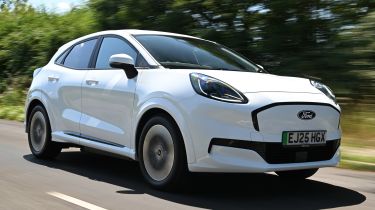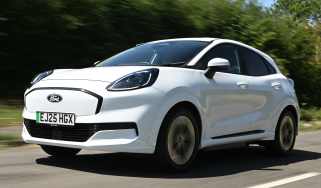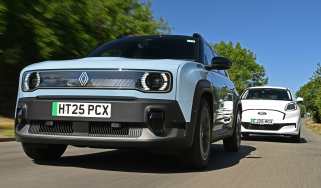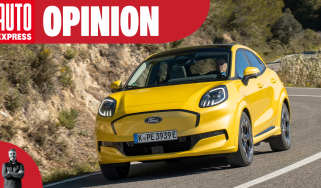Ford Puma Gen-E review
Big-selling crossover now comes with an all-electric powertrain. Does it offer any compromises?

Our opinion on the Ford Puma Gen-E
Switching from petrol to electric drive hasn’t really harmed the Ford Puma driving experience, and the Gen-E is still one of the most entertaining small SUVs to drive. The extra weight of the battery boosts driving comfort, though, while silent running even at motorway speeds means the Puma Gen-E is a relaxing cruiser. A 200-mile real-world range is roughly on a par with rivals, even though the Gen-E has a smaller battery, while there’s been no impact on interior space. That means the Puma is still a little cramped in the back, but the vast boot has been made even more useful with enlarged under-floor storage. Prices are competitive, too, so the Puma Gen-E deserves to be a big seller.
| Key specs | |
| Fuel type | Electric |
| Body style | Five-door, five seat small SUV |
| Powertrain | 43kWh (usable) battery, 166bhp electric motor, front-wheel drive |
| Safety | Four-star Euro NCAP (2022) |
| Warranty | Three years/60,000 miles |
About the Ford Puma Gen-E
While Ford fast-tracked the Ford Explorer and Ford Capri to market by tapping into Volkswagen’s EV expertise, the Puma Gen-E is a pure Blue Oval product. It’s the company’s smallest electric model and is based on the big-selling petrol version, but with a few key changes. There are three variants in the line-up: Select, Premium, and Sound Edition.
Entry-level Select comes with all the equipment you'll need. It includes:
- Wireless phone charging
- LED headlights
- Rear view camera with rear parking sensors
- Lane keep assistance
Used - available now
Premium trim comes with a few more luxury features over the standard Select trim, adding:
- 18-inch alloys
- Adaptive LED headlights
- Keyless entry and start
- An electric tailgate
The priciest Sound Edition special edition comes with unique alloy wheels and interior seat trim, but for the most part, it is a Premium trim Gen-E with the winter and advanced driver assistance packs added, plus a contrast black roof. All of these options can be specified on a Premium trim Gen-E for less money than a Sound Edition costs over a Premium trim car.
The Ford Puma Gen-E is the first electric car to meet the criteria required for the full £3,750 discount as part of the Government's Electric Car Grant (ECG), announced in July 2025, thanks to part of its electric powertrain being manufactured in the UK.
If you like the idea of owning a Ford Puma Gen-E, then our Buy a Car service is here to help. You can also configure your ideal Ford Puma Gen-E and receive great offers from our network of dealerships, take a look at the best Ford Puma Gen-E leasing deals or choose from a huge selection of top-notch used Ford Puma Gen-E models. Need to sell your car? Be sure to visit our Sell My Car page.
Performance & driving experience
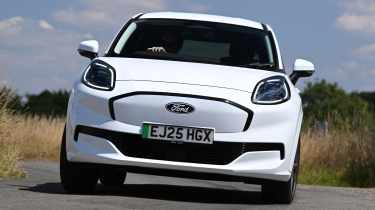
| Pros |
|
| Cons |
|
With extra weight to haul around, the Gen-E can’t match the standard Puma for driving fun, but it’s still an entertaining small SUV, and there’s a bit more comfort in the mix, too.
Ford has done a good job of packaging the electric drivetrain within a bodyshell that was originally designed for combustion engines. Visual clues to the Gen-E include the smoothed-off front bumper and white Puma lettering on the tailgate, while the black housing for the car’s drive battery hangs below the sills – the Gen-E has 129mm of ground clearance as a result, which is 34mm less than the petrol car.
Electric motors, 0-60mph acceleration and top speed
There’s just one powertrain option offered in the Puma Gen-E, which comprises a lithium-ion battery with a usable capacity of 43kWh, and a 166bhp/290Nm electric motor that sends drive to the front wheels.
Kerbweight has increased by 195kg to 1,563kg, compared with 1,368kg for an EcoBoost auto-equipped model, but the Gen-E’s output places it just behind the 168bhp Puma ST Powershift, with a 0-62mph time of eight seconds exactly; 0.6 seconds behind the performance flagship’s figure.
| Model | Power | 0-62mph | Top speed |
| Ford Puma Gen-E | 166bhp | 8.0 seconds | 93mph |
Town driving, visibility and parking
The Puma Gen-E combines the agile handling and responsive steering of the petrol model with the instant responses of an electric powertrain. Combine this with compact dimensions and decent visibility, and overall, the Gen-E is well suited to the cut and thrust of urban driving, although the ride will be a little on the firm side for some.
An interesting omission is the lack of a handbrake. Instead, the parking brake is only activated when you press the button on the end of the drive selector (located on the right-hand side of the steering column). To prevent the car rolling at other times, auto-hold is fitted and operates as standard. We found it a little jerky when engaging or disengaging, which can compromise low-speed manoeuvring in tight spaces.
One-pedal driving is available, but unlike some rivals, it’s fiddly to access via the touchscreen. There’s also an ‘L’ mode that’s selected via a button on the drive selector. This delivers the braking strength of the one-pedal setting, but without seeing the car come to a complete halt.
B-road driving and handling
One area where the petrol Puma impresses is with its handling on twistier roads, and the Gen-E follows the same formula. There’s a bit more weight to contend with, but it’s set low in the chassis and body roll is kept in check reasonably well. There’s lots of grip, but when the Puma does reach the limit, it is neutral with a bias towards understeer.
Selectable drive modes include a Sport setting that further sharpens acceleration, as well as changing the colour of the dashboard highlights. Slippery and Eco settings are also available. The latter dulls the car’s response and limits the climate control, too.
Motorway driving and long-distance comfort
Perhaps the biggest change with the switch to electricity is a boost to the Puma’s high-speed refinement. There’s next to no wind or road noise in the Gen-E when travelling at the motorway limit, while the softer edge to the ride improves comfort, too.
Throttle response at higher speeds is good – in many small electric cars the powertrain can run out of steam the faster you go, but the Puma still delivers quick reactions when needed.
"Separate from the drive modes is a sound generator for those who need some audible connection with the powertrain. Ford has come up with an interesting sound that has hints of the EcoBoost three-cylinder growl, but becomes more electronic the faster you go" - Dean Gibson, senior test editor
Range, charging & running costs

| Pros |
|
| Cons |
|
A sub-£30,000 starting price means the Puma looks attractive, but while it has a small battery, excellent efficiency makes best use of the capacity that’s available.
Electric range, battery life and charge time
The Puma Gen-E has a 53kWh battery that’s on a par with the likes of the Renault 4 and Stellantis’s small SUVs, but only 43kWh of its capacity is available for driving. That’s quite a significant amount left in reserve, but thankfully, the Ford has efficiency on its side.
We tested the Puma Gen-E at the height of summer in 30-plus-degree heat, and yet a return of 4.7 miles per kWh is among the best figures we’ve seen from any EV. That puts the Puma Gen-E ahead of the Renault 4, which we pitched it against, which managed 4.0mi/kWh.
Even a longer stint of motorway driving couldn’t shift the average below 4.4mi/kWh, while figures in the 5-6mi/kWh range were easily achieved at urban speeds. The fact that the Puma Gen-E manages this without compromising its driving ability makes the figures even more impressive. The small battery means a range of 202 miles at the rate we achieved on test, but that’s a similar distance to that posted by less efficient rivals with larger usable packs.
Charging speeds are a little disappointing, with a maximum rate of 100kW on offer. That’s the same figure achieved by the Renault 4/5, and means the Puma can go from 10-80 per cent capacity in 23 minutes when plugged into a powerful enough DC source.
| Model | Battery size | Range | Insurance group |
| Ford Puma Gen-E | 43kWh | 234 miles | 18 |
Insurance groups
The Puma’s sheer numbers mean that parts availability is good, although the Gen-E is in car insurance groups 18 and 19, with only the high-performance Puma ST sitting higher. That’s still a pretty good group rating, though; electric versions of the Peugeot 2008 and Vauxhall Mokka sit in group 22 and higher, while the Renault 4 is in groups 27 and 28.
Tax
Low list prices mean that the Puma Gen-E will be a cheap company car to run. Road tax for the Gen-E is the same as that for the standard Puma (£195) since EVs now pay it at the same rate as any combustion-engined car.
Depreciation
The Puma’s ubiquity means that residuals are only average, but the Gen-E performs just as well as its petrol sibling, retaining between 48 to 50 per cent of its original value after three years or 36,000 miles. In comparison, the hotter Puma ST retains 54 per cent
That's a lot better than the Vauxhall Frontera, which in electric form is only expected to retain around 37 per cent of its original value.
Interior, design & technology
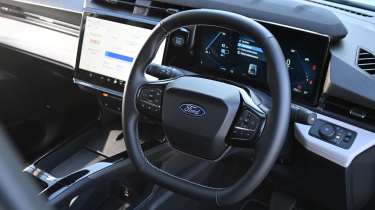
| Pros |
|
| Cons |
|
With the demise of the Ford Fiesta, it’s down to the Puma to fly the flag for Ford’s small cars, and as a result, it has become a common sight on UK roads. That’s no bad thing, because its compact dimensions and tight proportions mean it looks smart. The Gen-E adds a smoother nose up front and machined alloy wheels that look as if they should boost efficiency, but overall, the look remains unchanged.
Interior and dashboard design
Inside, the big updates are to the centre console, where a new split-level design is used. The drive selector has moved to the steering column – as with Ford’s other EVs, the Gen-E has its indicators and wipers on a single stalk to the left of the wheel.
Materials and build quality
The Gen-E feels just as well built as the petrol Puma, with harder plastics lower down in the cabin that feel sturdy, plus leather-effect trim on the dashboard for a more premium feel. One gripe we have is that the new centre console is finished in gloss-black plastic, which feels as if it will pick up scratches easily.
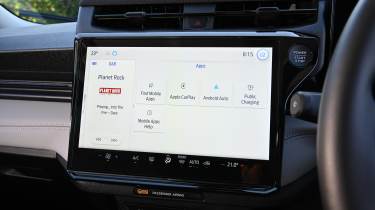
Infotainment, sat-nav and stereo
The most recent update to the Puma introduced a dashtop sound bar, similar to the set-up found in the Explorer and Capri. It comes with B&O branding on the higher-spec Premium and Sound Edition trims.
As with a number of newer Fords, the Puma’s touchscreen features the climate controls as a permanent fixture across the bottom of the display. They’re easy enough to use on the move, while the middle button is a shortcut to the main climate screen for air vent controls, although the three-stage Auto setting is effective enough to use on its own.
The Puma’s 12-inch display looks vast, and the sharp graphics and quick responses mean it’s a pleasant enough system to use. The home screen is split into three sections and is fine to use this way, or you can select one function to take up the whole screen – although there’s still a side bar that allows you to flip between functions.
There’s a home button in the top-right corner of the display to get you back, but the screen’s sheer size means it’s a little lost in the pale blue background that Ford uses.
"Ford isn’t shy with rolling out special editions, and new on the list is the Puma Gen-E Sound Edition. This provides enhancements to the cabin audio, while exterior upgrades include grey 18-inch alloys, an exclusive Metropolis White option, plus a black roof and door mirror caps." - Dean Gibson, senior test editor
Boot space & practicality
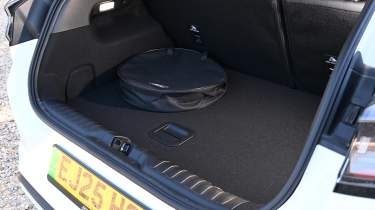
| Pros |
|
| Cons |
|
It’s small, but the Puma packs a lot of usable space within its compact dimensions.
Dimensions and size
The Puma Gen-E has exactly the same dimensions as the petrol model, so that means it’s compact, but clever packaging means there’s plenty of usable space within its length.
| Dimensions | |
| Length | 4,313mm |
| Width | 1,805mm |
| Height | 1,555mm |
| Number of seats | Five |
| Boot space | 556-1,283 litres |
Driving position, seats & space in the front
A high centre console divides the Gen-E’s cabin more than in the petrol Puma, while the car’s narrow body means it feels more snug than in some rivals. There’s plenty of wheel and seat adjustment, though, so it’s not cramped, while the door bins are a decent size, but a little awkwardly shaped.
There are trays on the top and bottom of the centre console with wireless charging above and sockets below, while most of the cabin controls are on the touchscreen – only a volume knob and switches for the hazard lights, drive modes and windscreen demister remain.
Seats & space in the back
It’s in the back where the biggest compromises are to be found with the Puma’s interior layout. However, it’s worth noting that the Gen-E demands no bigger compromises than the petrol model.
Knee and headroom are both tight, while sitting three-up in the back will be cramped – the rear bench is too narrow to allow space for an armrest to fold out of the centre seat. The small windows add to the claustrophobic feel, while hard plastics on the doors make it feel spartan – there are no air vents, just two USB-C sockets.
Boot space
What the Puma loses in passenger space, it makes up for with a vast boot. The main space looks pretty average, but lift the floor and you’re greeted by the GigaBox. It’s the same concept as the MegaBox in the standard petrol-powered car, being a plastic recess with a drain plug, but at 145 litres, it’s 65 litres larger. The Puma’s load lip is on the high side, while we’re still not fans of the rather flimsy fabric load cover that comes as standard on all Pumas.
Another interesting feature is that the Puma has storage under the bonnet - that’s almost unheard of for an EV that’s been converted from a petrol model. Ford quotes a capacity of 43 litres, but the shape of the area means it’s a bit awkward to get items in - a charging cable will barely fit.
"It’s one thing testing electric cars in the summer months, but in winter, colder temperatures will take a chunk out of the Puma’s driving range. Ford mitigates against this by fitting the Gen-E with a heat pump as standard, which is surprising because it’s an option on the pricier Explorer and Capri" - Dean Gibson, senior test editor
Reliability & safety
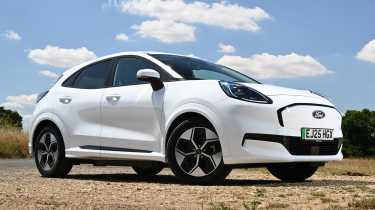
| Pros |
|
| Cons |
|
Euro NCAP’s four-star score for the petrol Puma also applies to the Gen-E, while the optional Advanced Driver Assistance Pack (£950) must be added if you want 360-degree cameras, front parking sensors, adaptive cruise control and blind-spot detection.
| Key standard safety features | Euro NCAP safety ratings |
|
|
In terms of warranty cover, Ford’s three-year/60,000-mile package is pretty average these days, although you can pay to extend cover up to five years and 100,000 miles. The Gen-E’s battery is covered for eight years or 100,000 miles.
One highlight of Puma Gen-E ownership is that if you buy now, it gets a five-year Ford Protect service package. This covers the first two services and adds roadside assistance for the duration of the cover, too.
Buying and owning
Best buy: Ford Puma Gen-E Select
We think that the base model has all the features you'll need, although we might add the Winter Pack for a heated steering wheel and front seats. It’s not much of a jump to upgrade to Premium spec, though.
Ford Puma Gen-E alternatives
A chief rival for the Puma Gen-E is the Renault 4 - it’s similarly priced, and when we tested the pair together, they were very closely matched for performance, range and equipment. What puts the R4 ahead, though, is the additional interior space for back-seat passengers.
Elsewhere, the small SUV sector is quite busy, with the Stellantis group offering a number of opponents. These include the Vauxhall Mokka Electric, Peugeot e-2008, Jeep Avenger and Alfa Romeo Junior. Or there’s the MINI Aceman as a sporty alternative, the Volvo EX30 and Hyundai Kona Electric or Kia EV3.
While it might be tempting to go for the range-topping Premium trim, we’d stick with the entry-level Select model. It has a marginally longer range thanks to its smaller 17in wheels, and it keeps the price competitive with its rivals. The reasonably priced Winter pack is a worthwhile addition for £350 to get heated seats and a heated steering wheel, and if you really want some additional driver assistance technology, you can add the Driving Assistance pack for £950, and still save yourself some money compared with the top-of-the-range trim.
Deals on the Ford Puma Gen-E and alternatives
Frequently Asked Questions
We’re big fans of the petrol Puma, and the Gen-E does nothing to spoil that car’s appeal. In fact it’s better in a couple of ways, such as the more comfortable ride, and the larger GigaBox under-floor boot storage.

